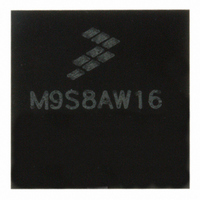MC9S08AW16MFGE Freescale Semiconductor, MC9S08AW16MFGE Datasheet - Page 197

MC9S08AW16MFGE
Manufacturer Part Number
MC9S08AW16MFGE
Description
IC MCU 8BIT 16K FLASH 44-LQFP
Manufacturer
Freescale Semiconductor
Series
HCS08r
Datasheet
1.MC9S08AW32CFDE.pdf
(324 pages)
Specifications of MC9S08AW16MFGE
Core Processor
HCS08
Core Size
8-Bit
Speed
40MHz
Connectivity
I²C, SCI, SPI
Peripherals
LVD, POR, PWM, WDT
Number Of I /o
34
Program Memory Size
16KB (16K x 8)
Program Memory Type
FLASH
Ram Size
1K x 8
Voltage - Supply (vcc/vdd)
2.7 V ~ 5.5 V
Data Converters
A/D 8x10b
Oscillator Type
Internal
Operating Temperature
-40°C ~ 125°C
Package / Case
44-LQFP
Lead Free Status / RoHS Status
Lead free / RoHS Compliant
Eeprom Size
-
Available stocks
Company
Part Number
Manufacturer
Quantity
Price
Company:
Part Number:
MC9S08AW16MFGE
Manufacturer:
Freescale Semiconductor
Quantity:
10 000
Part Number:
MC9S08AW16MFGE
Manufacturer:
FREESCALE
Quantity:
20 000
- Current page: 197 of 324
- Download datasheet (4Mb)
Chapter 11 Serial Communications Interface (S08SCIV2)
systems with modems to determine when it is safe to turn off the modem. If the transmit complete interrupt
enable (TCIE) bit is set, a hardware interrupt will be requested whenever TC = 1. Instead of hardware
interrupts, software polling may be used to monitor the TDRE and TC status flags if the corresponding TIE
or TCIE local interrupt masks are 0s.
When a program detects that the receive data register is full (RDRF = 1), it gets the data from the receive
data register by reading SCIxD. The RDRF flag is cleared by reading SCIxS1 while RDRF = 1 and then
reading SCIxD. If the SCI is configured to operate in 9-bit mode, an additional read to the SCIxC3 register
is required to clear RDRF
When polling is used, this sequence is naturally satisfied in the normal course of the user program. If
hardware interrupts are used, SCIxS1 must be read in the interrupt service routine (ISR). Normally, this is
done in the ISR anyway to check for receive errors, so the sequence is automatically satisfied.
The IDLE status flag includes logic that prevents it from getting set repeatedly when the RxD line remains
idle for an extended period of time. IDLE is cleared by reading SCIxS1 while IDLE = 1 and then reading
SCIxD. After IDLE has been cleared, it cannot become set again until the receiver has received at least one
new character and has set RDRF.
If the associated error was detected in the received character that caused RDRF to be set, the error flags —
noise flag (NF), framing error (FE), and parity error flag (PF) — get set at the same time as RDRF. These
flags are not set in overrun cases.
If RDRF was already set when a new character is ready to be transferred from the receive shifter to the
receive data buffer, the overrun (OR) flag gets set instead and the data and any associated NF, FE, or PF
condition is lost.
11.3.5
Additional SCI Functions
The following sections describe additional SCI functions.
11.3.5.1
8- and 9-Bit Data Modes
The SCI system (transmitter and receiver) can be configured to operate in 9-bit data mode by setting the
M control bit in SCIxC1. In 9-bit mode, there is a ninth data bit to the left of the MSB of the SCI data
register. For the transmit data buffer, this bit is stored in T8 in SCIxC3. For the receiver, the ninth bit is
held in R8 in SCIxC3.
When transmitting 9-bit data, write to the T8 bit before writing to SCIxD for coherent writes to the transmit
data buffer. If the bit value to be transmitted as the ninth bit of a new character is the same as for the
previous character, it is not necessary to write to T8 again. When data is transferred from the transmit data
buffer to the transmit shifter, the value in T8 is copied at the same time data is transferred from SCIxD to
the shifter.
When receiving 9-bit data, clear the RDRF bit by reading both R8 and SCIxD. R8 and SCIxD can be read
in either order.
MC9S08AW60 Data Sheet, Rev 2
Freescale Semiconductor
197
Related parts for MC9S08AW16MFGE
Image
Part Number
Description
Manufacturer
Datasheet
Request
R
Part Number:
Description:
Manufacturer:
Freescale Semiconductor, Inc
Datasheet:
Part Number:
Description:
Manufacturer:
Freescale Semiconductor, Inc
Datasheet:
Part Number:
Description:
Manufacturer:
Freescale Semiconductor, Inc
Datasheet:
Part Number:
Description:
Manufacturer:
Freescale Semiconductor, Inc
Datasheet:
Part Number:
Description:
Manufacturer:
Freescale Semiconductor, Inc
Datasheet:
Part Number:
Description:
Manufacturer:
Freescale Semiconductor, Inc
Datasheet:
Part Number:
Description:
Manufacturer:
Freescale Semiconductor, Inc
Datasheet:
Part Number:
Description:
Manufacturer:
Freescale Semiconductor, Inc
Datasheet:
Part Number:
Description:
Manufacturer:
Freescale Semiconductor, Inc
Datasheet:
Part Number:
Description:
Manufacturer:
Freescale Semiconductor, Inc
Datasheet:
Part Number:
Description:
Manufacturer:
Freescale Semiconductor, Inc
Datasheet:
Part Number:
Description:
Manufacturer:
Freescale Semiconductor, Inc
Datasheet:
Part Number:
Description:
Manufacturer:
Freescale Semiconductor, Inc
Datasheet:
Part Number:
Description:
Manufacturer:
Freescale Semiconductor, Inc
Datasheet:
Part Number:
Description:
Manufacturer:
Freescale Semiconductor, Inc
Datasheet:











